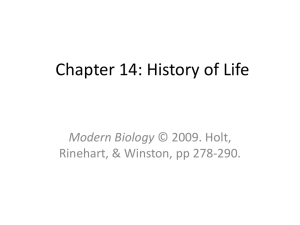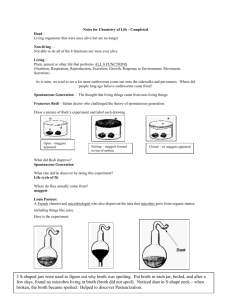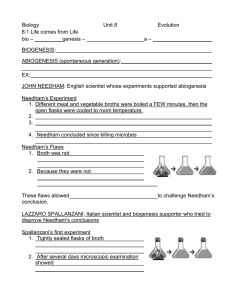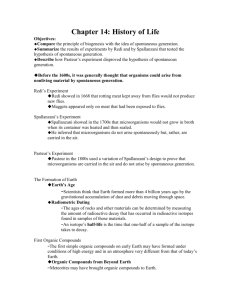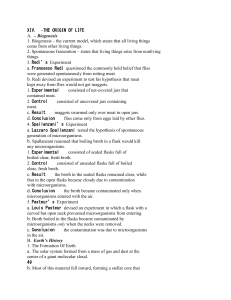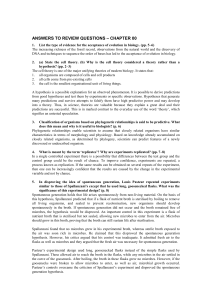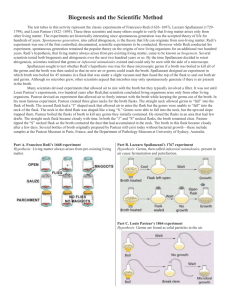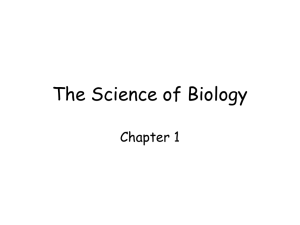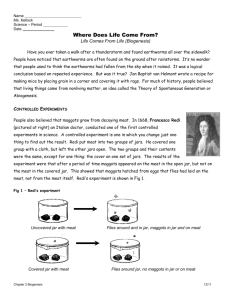Redi Spallazani Pasteur Notes
advertisement
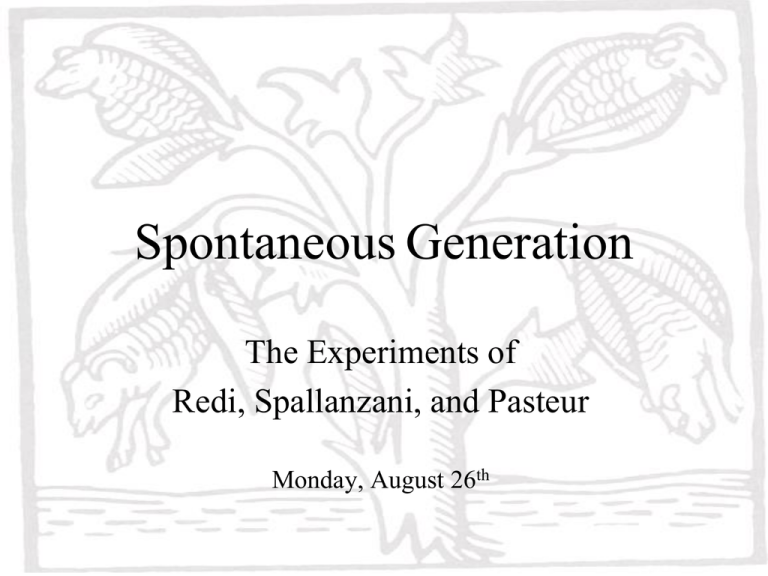
Spontaneous Generation The Experiments of Redi, Spallanzani, and Pasteur Monday, August 26th What is Spontaneous Generation? • For MUCH of history, people believed: – Frogs developed from falling drops of rain – Mice arose from sweaty underwear • This is called abiogenesis or spontaneous generation – Living things “come” from non living material * One of the first “theories” of spontaneous generation… • Living mice could be generated spontaneously from wheat and a sweaty shirt – The wheat =nutritive power – The shirt = active principle • The active principle = a mysterious “life-force” that allowed spontaneous generation to occur. 1668 - Francisco Redi attempted to disprove spontaneous generation. What was Redi’s Experiment? • When he did it: – 1668 • What he did: – Put dead snakes, eels, and veal in glass jars – Sealed one set with wax; the other remained open * What was Redi’s Experiment? • What he found: – Uncovered meat was covered with maggots – Sealed meat had no maggots • What he determined: – Wax sealed jars failed to produce maggots because flies were unable to reach the meat * Why was Redi not believed? • He has “too many variables” • There is a lack of access and a lack of air • We ALL know that everything needs air – So of course no flies grew! • He hadn’t proven anything * Redi part 2 – His response to critics Fine mesh allows in air, but not flies Flies laid eggs on top of mesh no maggots in meat What was Redi’s conclusions? • “All living beings come from seeds of the plants or animals themselves” • However, if someone were to demonstrate even 1 exception to this hypothesis, then Redi’s hypothesis would be rejected. • Redi’s Experiment 1768 - Spallanzani What was Spallanzani’s Experiment? • When he did it: – 1768 • What he did: – 1st experiment – Boiled flasks with broth (chopped hay in water) – Sealed the flasks after boiling (airtight) • What he found: – There was NO bacterial growth in the flasks with airtight seals * What was Spallanzani’s Experiment? • What he did in response to critics: – 2nd experiment – Timed boilings – Left some partially sealed, others airtight sealed • What he found: – There STILL was no bacterial growth in the flasks that were sealed * What was Spallanzani’s Experiment? tight seal • What he determined: – Boiling did NOT damage broth’s ability to support life – Growth depended on the SEAL only 30 mins 60 mins 90 mins 120 mins * loose seal Critics of Spallanzani’s Experiment • He boiled it TOO LONG • He spoiled the vegetative power by boiling • He killed the ability of the broth to give life • Life can still come from broth, BUT the broth must not be “damaged” by boiling What was Pasteur’s Experiment? • When he did it: – 1859 • What he did: – Used swan-necked flasks – Flasks allowed in air, but trapped dust (and microbes) in the curve because they couldn’t overcome gravity – Boiled broth to force the air out – Broke the necks off of some of the curved flasks * What was Pasteur’s Experiment? * • What he found: – NO growth occurred in the flasks with the curved necks, even after weeks – After 1 year, he broke off the curved necks and within a few days, the broth became cloudy • What he determined: – The “active principle” was not damaged through boiling – The AIR contained MICROBES 1859– Louis Pasteur
